
You have seen Googie architecture — you just don’t know it.
Googie architecture is the futuristic, Jetsons-like architecture used for the facade and interior of many cafes, eateries, motels, gas stations, drive-in movies, and other commercial buildings in the 1950’s and 1960’s.
Googie’s Coffee Shop in LA
The term Googie comes from Googie’s Coffee Shop in Hollywood, designed by John Lautner in 1947. “Googie” was the nickname of Lillian K. Burton, the wife of one of the restaurant’s original owners, Mortimer C. Burton. She was also the aunt of famous musician Peter Matz — a composer and conductor who worked with Barbara Streisand.
Googie’s Coffee Shop was located at 8100 Sunset Boulevard, at the corner of Sunset Boulevard and Crescent Heights, next door to the famous Schwab’s Pharmacy.

Burton opened the shop with co-owner Ernie Goldenfeld. In 1954, they sold the coffee shop to Ed Thrasher — a photographer and artist who became famous for advancing the record album design industry.
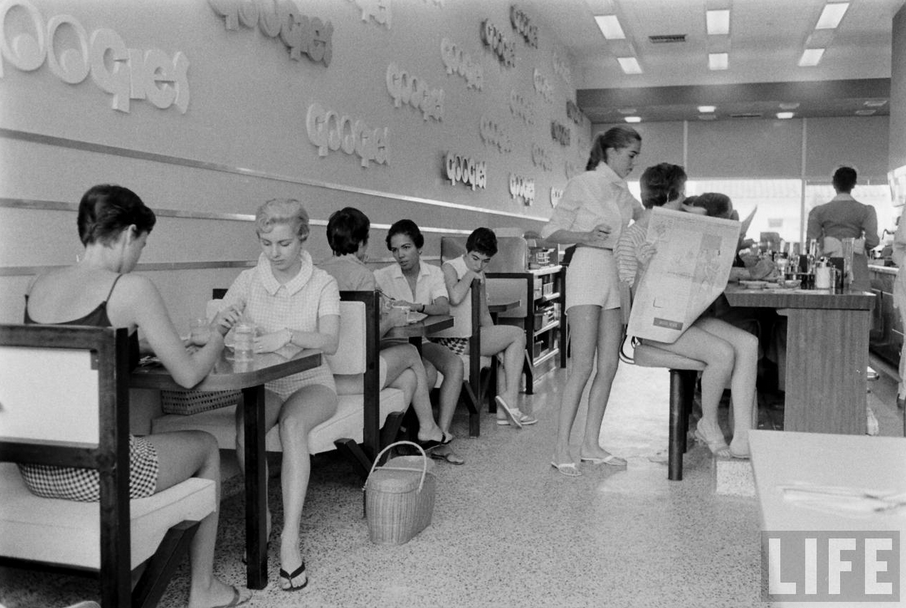
The restaurant became a popular hangout for young Hollywood elite — James Dean, Steve McQueen, Marilyn Monroe, Natalie Wood, Lee Marvin, and the like. Comedian Lenny Bruce famously got into a fight inside the restaurant in 1957 and was thrown through a plate glass window.
House & Home Magazine’s Editor Coined ‘Googie Architecture’
The term “Googie Architecture” was first coined by House & Home magazine editor Douglas Haskell, who was reportedly driving on Sunset Strip in Los Angeles in 1952 with architectural photographer Julius Shulman when he spotted Googie’s Coffee Shop, stopped the car, and exclaimed “This is Googie architecture!”– then wrote an article ripping the style in the February 1952 issue of the magazine (starts on page 86).
The style was becoming prevalent all over town, and Haskell felt Googie’s Coffee Shop was the epitome of it. Haskell’s article mocked the style for its frivolity, influenced by Hollywood’s tackiness.

Haskell wrote the article in the voice of two fictitious characters — a professor and a student:
“We call it Googie architecture,” said Professor Thrugg, “named after a remarkable restaurant in Los Angeles called Googie’s. That’s one you should see. (Photo, above). It starts off on the level like any other building. But suddenly it breaks for the sky. The bright red roof of cellular steel decking suddenly tilts upward as if swung on a hinge, and the whole building goes up with it like a rocket ramp. But there is another building next door. So the flight stops as suddenly as it began.”
“It seems to symbolize life today,” said the Professor. “Skyward observation blocked by Schwab’s Pharmacy.”
“My Los Angeles companion saw it differently,” continued the Prof. “He said, ‘looks funny, but I guess the guy has the right to do it that way if it attracts attention to his business.'”
“Is it the commercial motive?” asked a student, getting out his notes. “Do you mean that Googie Architecture is like Mother Goose — night clubs and gas stations shaped like Cinderella slippers or old-ladies-who-lived-in-the-shoe or stucco pumpkins?”
“No,” answers the Professor — and the dialog goes back and forth for the rest of the article, as the Professor details what Googie is..
“The first is that although it must look organic it must be abstract. If a house looks like mushrooms. they must be abstract mushrooms. If it looks like a bird, this must be a geometric bird. (Nothing so naive as Mother Goose!). It’s better yet if the house has more than one theme: like an abstract mushroom surrounded by an abstract bird. Paraphrasing Oscar Wilde, the Googie architect declares. ‘When the public can’t make it out, the artist is in harmony with himself.’ “
It is a delightful read and again — the full pdf is here, with article starting on page 86: February 1952 issue of the magazine.

The Googie Design
Besides Haskell’s observations above, the chief elements of Googie Design are considered to be:
- Space Age design symbolic of motion
- Boomerang shapes
- Starbursts
- Buildings resembling spacecraft or flying saucers
- Atomic shapes based on the atomic model
- Roofs slopping at an upward angle
- Cantilevered ceilings
- Domed roofs
- Tailfins on buildings
- Glass as a design element
- Illuminated plastic paneling
- Shapes that resemble an artist’s palette with cutouts
- Exposed steel beams
- In general — “a high-energy explosion” as Alan Hess puts it.
How Googie Architecture Came to Be
Googie was born out of the Streamline Moderne architecture of the 1930’s. It has been theorized — most notably by Architect Analyst Alan Hess — that Googie architecture developed out of the need to Boldly advertise locations off the side of the road to the burgeoning car traffic of the 1950’s.
The automobile caused businesses to spring up along the roadside outside of the downtowns of cities and towns for easier accessibility. Owners of those businesses needed a visual imagery to attract customers.
Whereas Streamline Moderne became popular because of its sleek, high energy designs — symbolizing, according to Hess, “invisible forces of speed and energy” that reflected the influx of mobility that cars, locomotives and zeppelins brang — Googie Architecture took it to the Space and Nuclear age.
The First Googie Architects
Although Googie’s Coffee House is definitely the muse for how the genre was eventually named — Googie’s Coffee Shop itself was not the first building to feature the Googie Architecture.
And it is important to understand that the architecture movement was not all of a sudden called Googie because of the House & Home article. Designers were simply using a Futuristic architecture that used elements of Space Age and Atomic Age. At some point after the House & Home article it started to get generally referenced as Googie.
That said, it is up for debate who, in retrospect, the first Googie architect was.
Some say it was John Lautner, the designer of Googie’s Coffee House in 1947. Lautner not only designed Googie’s, but also designed many Atomic Age residential houses like the Leonard Malin House, the Paul Sheats House, and Russ Garcia House. Lautner was an apprentice of Frank Lloyd Wright.
Others say the first architect to develop the Googie style was Wayne McAllister, who designed Bob’s Big Boy restaurant in Burbank in 1949. That comes after Googie’s Coffee House in 1947, but before that McAllister designed a series of Streamline Moderne drive-ins during the 1930s, and then a series of coffee shop chains in the 1940’s through 1950’s that each had a unique style to provide brand recognition from the road.

The Armet & Davis architecture firm was also extremely influential to the movement — founded by Louis Armet and Eldon Davis, and interior designer Helen Liu Fong, who worked for the firm.
The Googie Influence
By the 1950’s into the 1960’s, Googie Architecture was everywhere — including in The Jetson’s cartoon.
Googie Architecture & Ben Frank’s People
Googie’s and Schwabb’s Pharmacy were rivaled by other hotspots for the young Hollywood elite crowd — most notably Ben Frank’s at 8585 Sunset Strip — which opened in 1962 and was especially a late-night hangout for young musicians as well as actors and actresses. Jim Morrison, Frank Zappa, Bob Dylan and you name it hung out there, with the beatniks and the hippies.
As Alison Martino (the daughter of singer Al Martino who played the Frank Sinatra character in Godfather) describes in her blog, Vintage Los Angeles, Ben Frank’s “A-framed structure which resembles a lodge or a chalet, had a Googie style swooped roof and neon sign that could be easily seen when cruising the strip. When local clubs closed for the night, young kids often congregated to ‘Ben Frank’s’ for coffee and an up-all-night chat. Purchasing a cheap cup of joe was enough to allow one to sit in the place for hours.”

Ben Frank’s Type of People = The Monkeys
Ben Frank’s clientele became recognized as a type of people — as famously advertised by NBC in the Hollywood Reporter in 1965 when doing a casting call for The Monkey’s tv show. They wrote: “Want spirited Ben Frank’s types.”
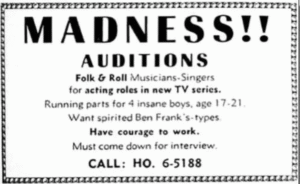
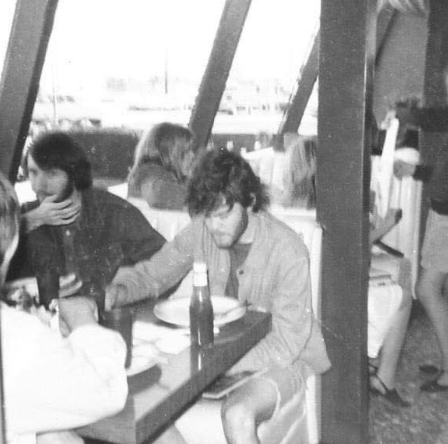
The Decline of Googie Architecture
By the 1970’s, Googie’s Architecture had become old hat and by the 1980’s, it became disregarded. Three Mile Island and the rise of anti-nuke movements made anything promoting nuclear to become out of place, and the end of the Apollo program and start of the Space Shuttle program made spaceships ho-hum.
By the 1970s, commercial buildings became bland — meant to blend into the environment. Many Googie-style buildings were thoughtlessly torn down to make room for the new.
A re-appreciation for Googie Architecture began at some point. It is hard to pinpoint when the masses started appreciating it more — but it may have started with the book Googie by Alan Hess in 1986.
The End of the Googie’s Coffee Shop
Googie’s Coffee Shop wasn’t the only Googie’s — later in the 1950’s Ed Thrasher opened up other stores:
- In 1955, a Googie’s was built at 5th & Olive Street in Downtown Los Angeles on the ground floor of the six-story San Carlos Hotel — designed by Architects Armet & Davis.
- Another Googie’s opened in the City National Bank building at 420 N. Roxbury Drive in Beverly Hills, California.
- Another Googie’s opened in the Atlantic Square shopping center at 2080 S. Atlantic Boulevard in Monterey Park, California.
But they all went away at some point.
Googie’s original Coffee Shop was bought and sold several times in the 1960’s through the 1980’s — operating as Gee Gee’s, Steak ‘n Stein, and Pippy’s Pizza before being bought, along with Schwab’s Pharmacy, by developer Condor Wescorp who demolished both in 1988 and built a 2-story shopping center called 8000 Sunset Strip.
If You See a Googie’s — Shout It Out
The recent restoration of Roy’s Motel and Cafe — a classic motel and cafe on Route 66 in Amboy, California, in the heart of the Mojave Desert between LA and Las Vegas — has been getting social media attention. The new owners recently renovated and re-erected its classic Googie, 50-foot neon sign that was first erected in 1959.
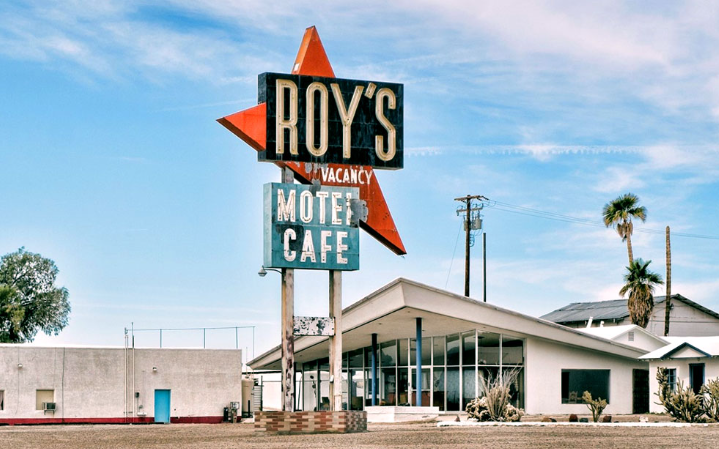
From the VisitAmboy (California) website: “The famous 50 ft “Roy’s Motel & Café” neon sign is erected. Following the sign, the remodeling of the reception office brought new life to the town with it’s Googie, “retro-future” architecture. The sign could be seen for miles while approaching Amboy.”
The Jetsons
Look familiar? Googie!
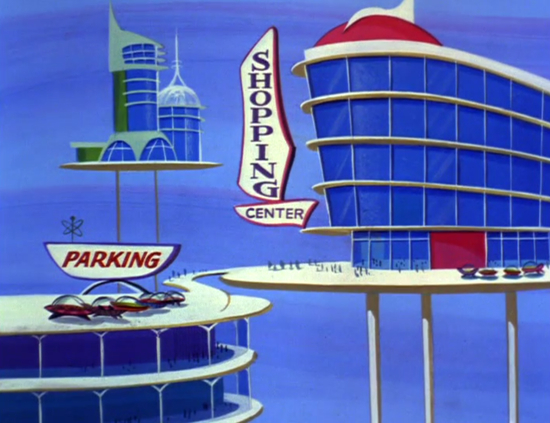
The Seattle Space Needle
The biggest Googie Architecture example of them all — Seattle’s Space Needle!

TWA Terminal (Hotel) at Kennedy Airport
The TWA Terminal at Kennedy Airport was constructed with Googie Architecture. In recent years the terminal has been refurbished and reopened as a hotel.
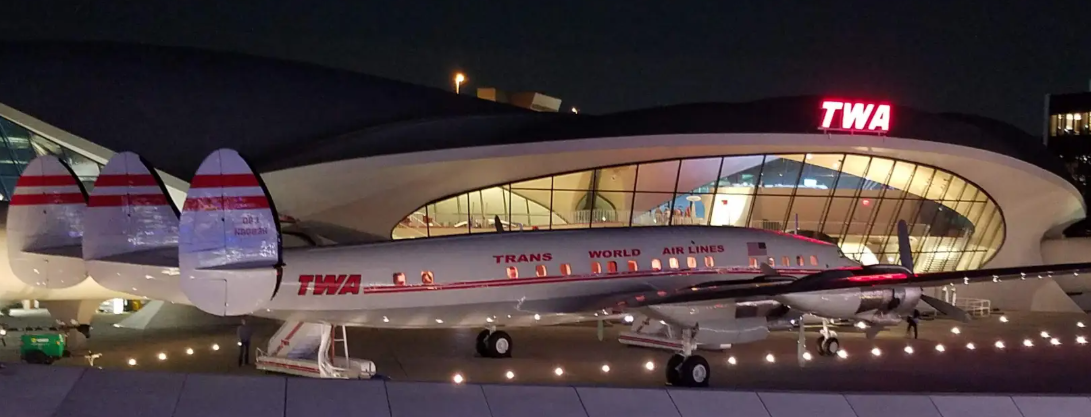
EAT Sign on Route 1 in NJ
The EAT sign by Jose Tejas on Route 1 in Woodbridge, NJ is definitely Googie. It was erected with the eatery in 1992. The history of Jose Tejas and it sister line, The Border Cafe is here.
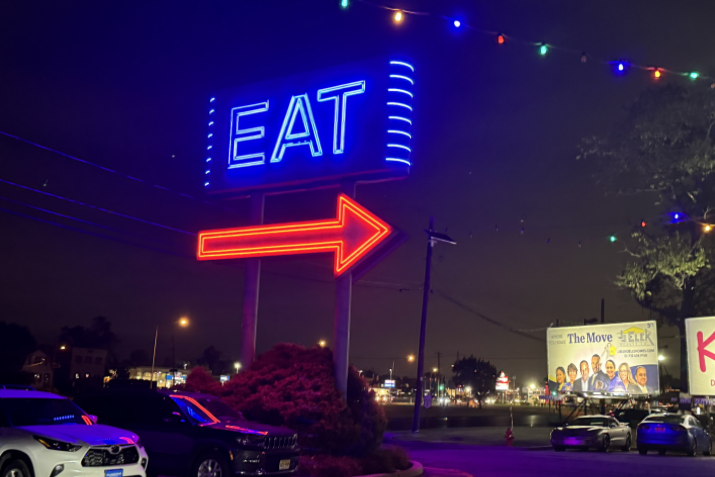
5 Points Car Wash — Now Called the Googie Car Wash
The 5 Points Car Wash was built in 1958 in Whittier, California. It has recently been renovated and has an Amazing website. Check out the animations and the car-wash deals:
- Googie Car Wash Website
- Googie Car Wash History of Googie
- Amazing Googie Car Wash timeline
- Googie Car Wash photo timeline
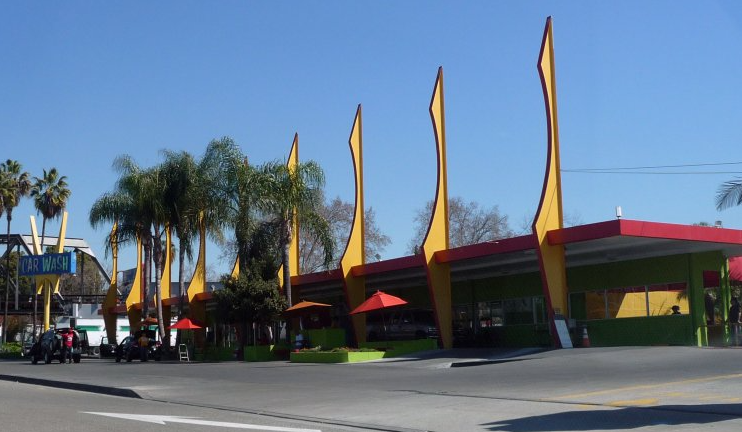
They have a video:
Other Amazing Resources
Here are some other resources to check out for some classic Googie Architecture:
- Martin Turnbull’s site and his photos on Googie’s Coffee Shop , including Googie’s under construction. Martin is the author of many books on Los Angeles.
- Curbed Los Angeles — and its article on Googie Architecture remaining in LA
- Alison Martino’s Vintage Los Angeles — and her article on Ben Frank’s
- Modern Living LA — and its article on Googie’s Coffee Shop
- Monique Anton‘s interview of Alan Hess describing Googie Architecture. THIS IS A FASCINATING INTERVIEW.

Be the first to comment